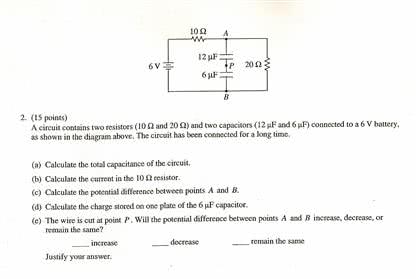PHYS1006 Lecture Notes - Lecture 5: Root Mean Square, Kilowatt Hour, Temperature Coefficient

Electric Currents
The electric cell
Volta discovered that electricity could be created if dissimilar metals were connected by a
conduction solution called an electrolyte.
This is a simple electric cell.
A cell transforms chemical energy into electrical energy.
Chemical reactions within the cell create a potential difference between the
terminals by slowly dissolving them.
This potential difference (PD) can be maintained even if a current is kept flowing,
until one or the other terminal is completely dissolved.
Several cells connected together make a battery
Electric Current
The electric current is the amount of charge flowing per unit time at any point in the circuit.
Current: I =
Q = Charge in Coulomb
t = time in second
Unit is ampere (A)
1A = 1C/s
smaller units are:
mA = 10-3 A
A = 10-6 A
CHARGE ON ONE ELECTRON e = 1.60 10-19C
Example 1
The current from a 2.0V battery of a pocket calculator is 0.17mA. In one hour of operation
how much charge flows in the circuit and how many electronics would this be?
Q = I t
Q = (0.17 10-3 C/s) 3600s
Q = 0.61C
Charge on one electron: e = 1.60 10-19C
find more resources at oneclass.com
find more resources at oneclass.com

Therefore, 0.61C would consist of:
n =
n = 3.8 1018 electrons
Ohm’s Law
The experiment shows that the current in a conductor is proportional to the potential
different (PD) between its ends, and inversely proportional to its resistance.
I V and I [Ohm’s Law]
Unit of resistance is ohm(V/A)
1 ohm =
Example 1
A small flashlight uses two 1.5V batteries in series to provide a current of 0.40A in the
filament. Determine the resistance of the glowing filament.
Resistance =
R =
R =
R = 7.5
Use of Resistors
Resistors are used in electronic circuits to limit the amount of current flowing through the
circuit.
Example 1
A typical device in a circuit requires 0.02A. What resistor should be used in the circuit if the
supply voltage is 12V? Assume the voltage drop across the device is 2V.
V = 1 R
R =
R =
R = 500
Resistivity
Experiment shows that the resistance (R) of any material is directly proportional to its length
(L) and inversely proportional to its cross-sectional area (A).
R L
R
p = resistivity of the material (m).
R = p p =
Example 1
What is the resistance of a length of Cu wire 1.5mm in
diameter?
find more resources at oneclass.com
find more resources at oneclass.com
Document Summary
Volta discovered that electricity could be created if dissimilar metals were connected by a conduction solution called an electrolyte. A cell transforms chemical energy into electrical energy. Chemical reactions within the cell create a potential difference between the terminals by slowly dissolving them. This potential difference (pd) can be maintained even if a current is kept flowing, until one or the other terminal is completely dissolved. The electric current is the amount of charge flowing per unit time at any point in the circuit. Q = charge in coulomb t = time in second. 1a = 1c/s smaller units are: ma = 10-3 a. Charge on one electron e = 1. 60 10-19c. The current from a 2. 0v battery of a pocket calculator is 0. 17ma. Q = (0. 17 10-3 c/s) 3600s. Charge on one electron: e = 1. 60 10-19c. Therefore, 0. 61c would consist of: n = n = 3. 8 1018 electrons.


